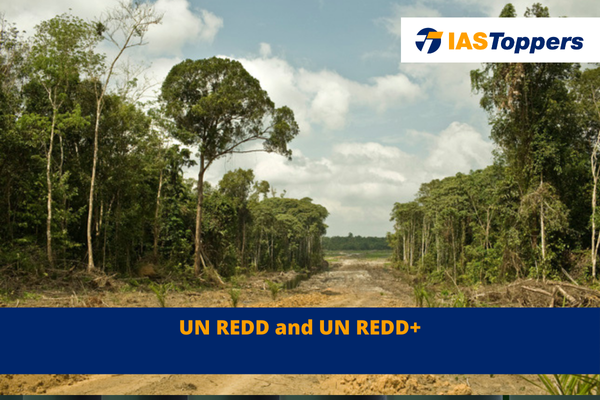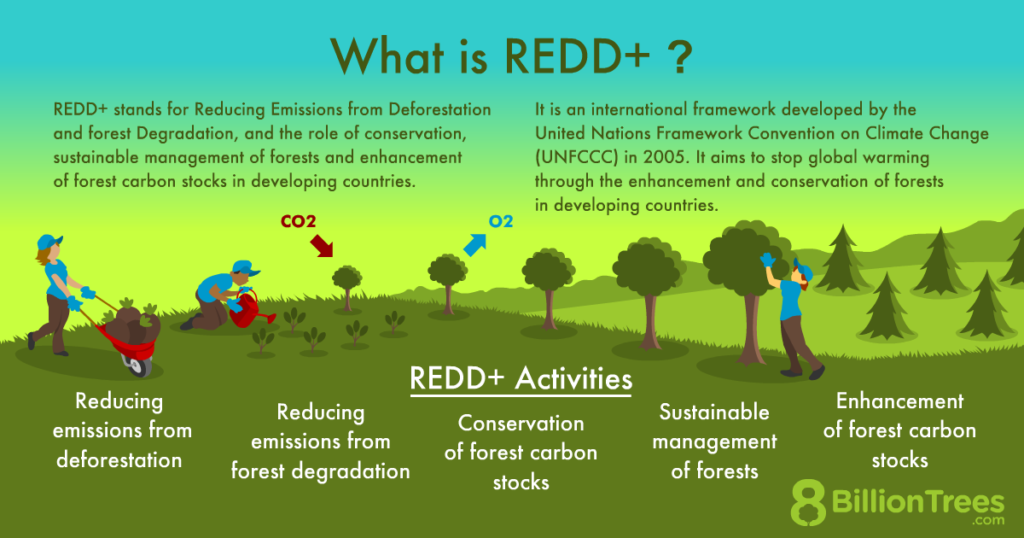REDD, or “Reducing Emissions from Deforestation in Developing Nations,” is a program designed to encourage developing countries to protect their forests in exchange for financial incentives. This idea was enhanced to REDD+, adding concepts of conservation, sustainable forest management, and increasing forest carbon stocks. Despite its noble intentions, REDD+ has faced criticism, including concerns about monitoring emissions reductions, conflicts with national strategies, potential exploitation of indigenous communities etc. In this article, you will learn meaning and definition of REDD and REDD+, its objective, activities under it and criticism. It is an important topic for GS Paper-3 Environment & Ecology of UPSC IAS Exam. To explore other interesting Environment & Ecology concepts, check out other articles and notes of IASToppers.
Table of Content
- What is REDD?
- What is REDD+?
- Phases of REDD+
- Eligible activities under REDD+
- Implementation of REDD+
- Criticism of REDD+
- UN-REDD Programme
- Support to Partner Countries
- Conclusion
- FAQs on REDD and REDD+
What is REDD?
- The original term REDD stands for “the reduction of greenhouse gas emissions resulting from deforestation in developing nations”. This was the title given to the initial REDD document.
- This concept evolved into REDD+ under the Warsaw Framework during REDD-plus negotiations.
- The concept of REDD came into existence during the 11th session of the Conference of the Parties (COP) in 2005 by the United Nations Framework Convention on Climate Change (UNFCCC).
- The proposition came from Costa Rica and Papua New Guinea, on behalf of the Coalition for Rainforest Nations.
- REDD’s basic principle is to offer financial incentives to developing countries that successfully reduce deforestation and degradation of forests.
What is REDD+?
- REDD+ (or REDD-plus) refers to “reducing emissions from deforestation and forest degradation in developing countries, and the role of conservation, sustainable management of forests, and enhancement of forest carbon stocks in developing countries.”
- UNFCCC developed REDD+ as a voluntary framework for mitigating climate change.
What is the objective of REDD+?
REDD+ seeks to motivate developing countries to participate in efforts to mitigate climate change by:
- Decreasing greenhouse gas emissions by slowing down, halting, and reversing forest loss and degradation.
- Increasing removal of GHGs from the earth’s atmosphere through the conservation, management and expansion of forests.
Phases of REDD+

Countries interested in REDD+ are have to progress through three phases, which are closely linked with one another:
- Readiness phase: Development of national strategies, REDD+ mitigation actions, and capacity building;
- Implementation of national strategies and results-based demonstration activities: Enacting REDD+ actions that for capacity building, technology transfer, and results-based demonstration activities;
- Results-based actions: These actions must be thoroughly measured, reported, and verified.
Eligible activities under REDD+
REDD+ has five “eligible activities” that developing countries can implement to reduce emissions:
- Reducing emissions from deforestation
- Reducing emissions from forest degradation
- Conservation of forest carbon stocks
- Sustainable management of forests
- Enhancement of forest carbon stocks
The first two activities aim to cut down greenhouse gas emissions and were listed in the original proposal on REDD+ in 2005 by the Coalition for Rainforest Nations. The three remaining activities constitute the “+” in REDD+.
Implementation of REDD+
All developing countries aiming to undertake REDD+ have develop the following for the monitoring of REDD+ activities:
- National strategy or action plan
- National forest reference emission level and/or forest reference level
- National forest monitoring system
- System for providing information social and environmental safeguards

Criticism of REDD+
Monitoring Issues
- There are worries about the capability to oversee emission reductions and greenhouse gas removals on a wide scale, across various countries each having their own environmental bodies and laws.
Conflict with National Strategies
- The REDD+ approach sometimes clashes with national development strategies, causing problems.
Participation and Funding Challenges
- There are concerns regarding the active participation of indigenous communities and forest dwellers in the maintenance of REDD+ activities.
- There are funding issues for the countries involving with REDD+, as well as consistent monitoring of forest resources to verify their permanence.
Natural Forests versus High-density Plantations
- The UNFCCC does not explicitly define a forest, which can create ambiguities and potential for misuse.
- There are fears that this lack of clarity might facilitate the conversion of natural forests into plantations, leading to biodiversity loss and negative environmental impacts.
- Also, there isn’t a universally accepted definition for forest degradation, creating room for misunderstandings and mismanagement.
Potential Exploitation and Displacement Concerns
- There are concerns that REDD+ could lead to irresponsible logging activities, displacement of local populations, and increase of tree plantations, under the guise of conservation.
- REDD+ might expose forests and their inhabitants to new forms of exploitation by corporations and market speculators.
- There is also fear of unfair contracts and exploitation of indigenous communities by unscrupulous businessmen.
- Critics also argue that placing commercial value on forests overlooks their spiritual significance to Indigenous Peoples and local communities.
REDD+ in Carbon Markets
- The debate over the use of market-based approach versus a fund-based approach for financing REDD+ has been a point of contention.
- Under a market-based approach, there’s a risk of a market flooded with carbon credits, which could make REDD+ economically unviable.
Influence of Large International Institutions
- There are concerns about the World Bank’s role in these processes, particularly due to past experiences with its weak consultation procedures and inadequate planning.
UN-REDD Programme
- It stands for United Nations Programme on Reducing Emissions from Deforestation and Forest Degradation.
- The UN-REDD Programme is a joint programme of:
- Food and Agriculture Organization of the United Nations (FAO),
- United Nations Development Programme (UNDP) and
- United Nations Environment Programme (UNEP)
- The program was established in 2008 in response to the UNFCCC decisions on the Bali Action Plan and REDD at COP-13.
- UN-REDD supports REDD+ initiatives led by nations and advocates for indigenous peoples and forest-dependent communities in REDD+ implementation at the national and international levels.
- UN-REDD relies completely on voluntary contributions.
- The Multi-Party Trust Fund Office provides real-time funding administration to the UN-REDD Programme.
In addition to UN-REDD, other initiatives such as the World Bank’s Forest Carbon Partnership Facility, Norway’s International Climate and Forest Initiative, the Global Environment Facility, Australia’s International Forest Carbon Initiative, the Collaborative Partnership on Forests, and the Green Climate Fund support countries etc, are engaged in REDD+.
Support to Partner Countries
The UN-REDD Programme supports its Partner Countries through:
- Direct funding and technical support to the implementation of National REDD+ Programmes;
- Complementary funding to national REDD+ actions; and
- Capacity enhancing support through sharing of expertise, common approaches, data, South-South knowledge sharing etc.
Conclusion
REDD and REDD+ represent a significant stride towards addressing climate change, offering economic incentives to protect and sustainably manage forests in developing nations. However, the successful implementation of these initiatives requires careful consideration of potential drawbacks, including exploitation risks and conflicts with local strategies. It is essential to continuously refine these approaches for genuine, equitable, and sustainable benefits.
ref:Source-1
| Other Articles in Environment & Disaster Management | |
| Deforestation | In-situ conservation |
| Eco Sensitive Zone (ESZ) in India | Ex situ conservation |
| Green GDP | Chipko movement |
FAQs ( Frequently Asked Questions)
What is the difference between Difference between REDD+ and the UN-REDD Programme?
REDD+ is a framework developed by the UNFCCC to reduce emissions from deforestation and promote forest conservation in developing countries. In contrast, the UN-REDD Programme is a specific initiative that provides technical and advisory support to these countries to help them implement REDD+ effectively and meet UNFCCC requirements.
What was Warsaw Framework for REDD-plus?
The Warsaw Framework for REDD+ established at COP19 provides a comprehensive set of rules and guidelines for countries to implement REDD+, ensuring the integrity, transparency, and robustness of the actions
What is the difference between Difference between REDD+ and the UN-REDD programs?
REDD+ is an approach encouraging developing nations to minimize emissions from deforestation and degradation. On the other hand, the UN-REDD Programme is a cooperative effort by UN agencies to provide tailored technical and advisory services to these countries, aiding in implementing REDD+ effectively.
How does the UN-REDD Programme support countries in implementing REDD+?
The UN-REDD Programme supports its partner countries by providing direct funding, technical support for National REDD+ Programmes, supplementary funding to national actions, and capacity-enhancing support through knowledge sharing and expertise exchange.



